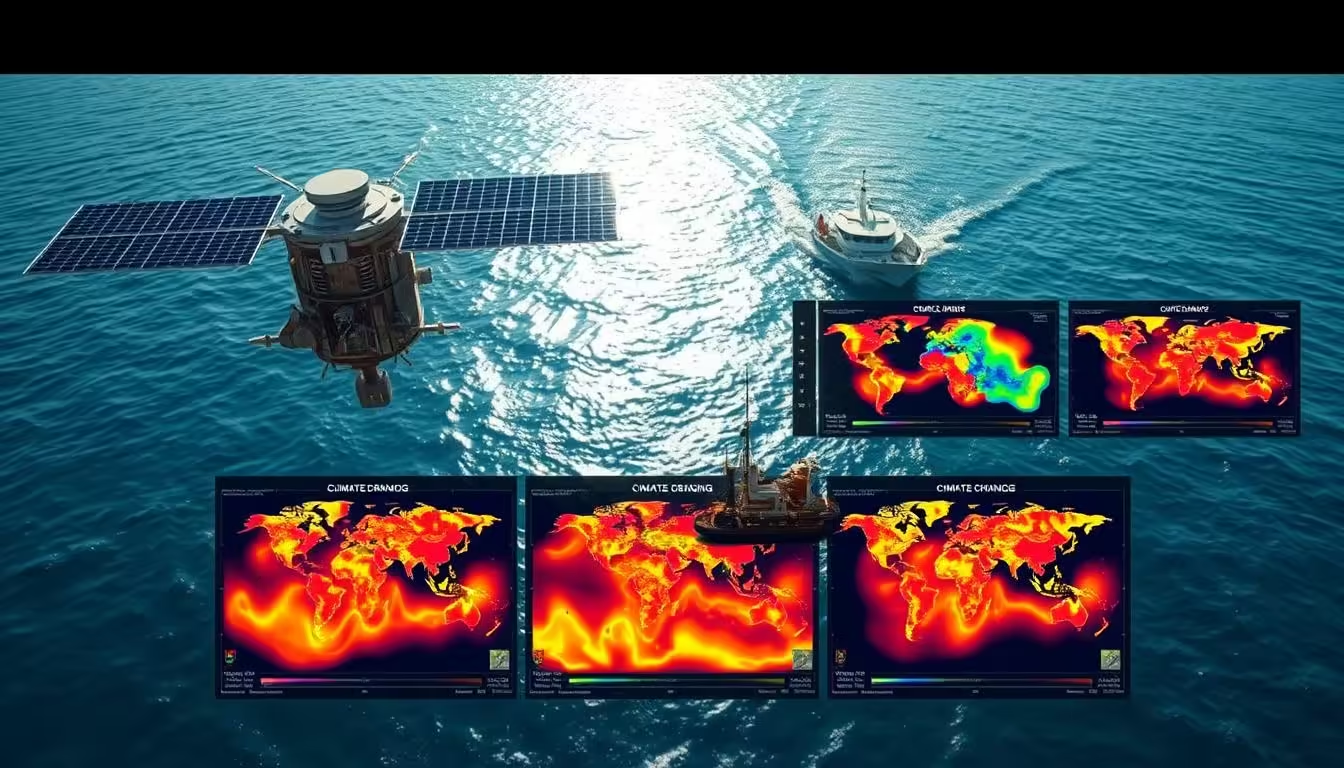Remote sensing technology has revolutionized the way scientists monitor the health of our planet. By utilizing advanced sensors and satellite imaging, researchers can now detect water pollution and track changes in ocean temperatures with unprecedented accuracy.

This breakthrough technology plays a vital role in understanding the impact of climate change on our environment. As the planet continues to face the challenges of a changing climate, remote sensing provides crucial data that helps scientists and policymakers develop effective strategies for sustainability.
Key Takeaways
- Remote sensing technology detects water pollution and monitors ocean temperatures.
- Advanced sensors and satellite imaging enhance research accuracy.
- Crucial data from remote sensing informs climate change mitigation strategies.
- Remote sensing supports sustainability and environmental protection efforts.
- Technological advancements aid in understanding climate change impacts.
The Evolution of Remote Sensing Technology in Environmental Monitoring
The journey of remote sensing technology from aerial photography to advanced satellite imaging has been pivotal in enhancing environmental surveillance. This evolution has not only improved the accuracy of data collection but has also expanded the scope of environmental monitoring.
From Aerial Photography to Advanced Satellite Imaging
The inception of remote sensing began with aerial photography, which provided a bird’s-eye view of the Earth’s surface. Over time, this technology evolved into sophisticated satellite imaging, enabling broader coverage and more detailed observations.

Key Technological Breakthroughs in Environmental Remote Sensing
Several technological advancements have driven the progress in remote sensing. These include:
Optical Sensors and Multispectral Imaging
Optical sensors capture data across various spectral bands, while multispectral imaging allows for the differentiation between various features on the Earth’s surface, such as vegetation health and water bodies.
Radar and Microwave Technologies
Radar and microwave technologies have enabled remote sensing to penetrate cloud cover and collect data regardless of weather conditions, significantly enhancing the reliability of environmental monitoring.
These breakthroughs have collectively contributed to the enhanced capability of remote sensing technology in monitoring environmental changes, detecting pollution, and supporting sustainability efforts.
How Remote Sensing Technologies Detect and Track Water Pollution
Remote sensing technologies have revolutionized the way we detect and track water pollution, offering a powerful tool for environmental monitoring. These technologies enable scientists to assess water quality and identify pollutants over large areas, providing critical data for sustainability efforts.
Spectral Analysis and Water Quality Assessment Techniques
Spectral analysis is a key technique used in remote sensing for water quality assessment. By analyzing the reflectance spectra of water bodies, scientists can identify various pollutants and assess their concentration. This method is particularly useful for detecting changes in water quality over time.
- Multispectral and hyperspectral imaging are used to capture detailed spectral signatures of water bodies.
- These signatures help in identifying specific pollutants, such as sediments, nutrients, and algae.
- Spectral analysis can also be used to monitor seasonal changes in water quality.
Real-time Monitoring Systems for Rivers, Lakes, and Coastal Waters
Real-time monitoring systems are crucial for tracking water pollution in dynamic environments like rivers, lakes, and coastal waters. Remote sensing technologies, combined with in-situ measurements, provide comprehensive data on water quality parameters.
These systems enable rapid response to pollution events, helping to mitigate their impact on the environment.

Case Studies: Major Water Pollution Detection Success Stories
Several case studies highlight the effectiveness of remote sensing in detecting and tracking water pollution. Two notable examples are the Great Lakes Restoration Initiative and the Gulf of Mexico Oil Spill Monitoring.
The Great Lakes Restoration Initiative
The Great Lakes Restoration Initiative has utilized remote sensing to monitor water quality and detect pollution in the Great Lakes. This initiative has helped in identifying areas of concern and guiding restoration efforts.
Gulf of Mexico Oil Spill Monitoring
During the Gulf of Mexico oil spill, remote sensing technologies played a critical role in monitoring the extent of the spill and assessing its impact on the environment. Satellite imagery and aerial surveys provided vital data for response efforts.
These case studies demonstrate the value of remote sensing in environmental monitoring and sustainability efforts, contributing to more effective management of water resources.
Advanced Technologies for Monitoring Ocean Temperatures
Monitoring ocean temperatures is crucial for understanding climate change, and advanced technologies are making this process more accurate and efficient. Ocean temperatures play a significant role in the Earth’s climate system, influencing weather patterns, sea levels, and marine ecosystems.
Satellite-Based Sea Surface Temperature Measurement Systems
Satellite-based systems have become a cornerstone in measuring sea surface temperatures (SST). These systems use infrared and microwave sensors to detect the temperature of the ocean’s surface. The data collected is crucial for understanding global climate patterns and for predicting weather events.

Underwater Temperature Monitoring: Argo Floats and Ocean Observatories
Underwater monitoring systems, such as Argo floats and ocean observatories, provide detailed temperature profiles of the ocean. Argo floats, for instance, drift through the ocean, collecting data on temperature and salinity at various depths. This information is vital for understanding ocean circulation patterns and their impact on climate.
Thermal Infrared Imaging Applications in Marine Environments
Thermal infrared imaging is another technology used to monitor ocean temperatures. This method involves measuring the infrared radiation emitted by the ocean’s surface, which can be used to determine the sea surface temperature. It’s particularly useful for studying coastal areas and detecting thermal anomalies.
| Technology | Application | Benefits |
|---|---|---|
| Satellite-Based SST | Measuring sea surface temperature | Global coverage, real-time data |
| Argo Floats | Underwater temperature profiling | Detailed depth profiles, long-term monitoring |
| Thermal Infrared Imaging | Sea surface temperature measurement | High-resolution data, useful for coastal studies |
The combination of these advanced technologies provides a comprehensive understanding of ocean temperatures, which is essential for climate change research and mitigation strategies.
The Critical Connection: Ocean Monitoring and Climate Change Science
The ocean plays a crucial role in regulating the Earth’s climate, making ocean monitoring a vital component of climate change science. Oceans cover over 70% of the Earth’s surface and are fundamental in absorbing heat and carbon dioxide, thus influencing weather patterns and climate conditions globally.
Oceans as Climate Regulators: The Heat Absorption Mechanism
Oceans act as massive heat sinks, absorbing and storing heat from the atmosphere. This process helps regulate global temperatures and weather patterns. The heat absorption mechanism is crucial for mitigating the effects of climate change, as it slows down the rate of global warming.
How Ocean Temperature Data Informs Climate Models and Predictions
Ocean temperature data is essential for informing climate models. By understanding how ocean temperatures vary over time, scientists can improve the accuracy of climate predictions. This data helps researchers identify trends and patterns that are critical for developing effective strategies to combat climate change.

Tracking Ocean Warming Trends and Their Global Impacts
Tracking ocean warming trends is vital for understanding the broader impacts of climate change. As oceans warm, they can lead to more extreme weather events, sea-level rise, and changes in marine ecosystems. Monitoring these trends helps scientists and policymakers develop targeted responses to mitigate these effects.
| Indicator | Trend | Impact |
|---|---|---|
| Ocean Temperature | Increasing | More extreme weather events |
| Sea Level | Rising | Coastal erosion and flooding |
| Marine Ecosystems | Changing | Biodiversity loss and fisheries impacts |
In conclusion, the connection between ocean monitoring and climate change science is critical for understanding and mitigating the effects of global warming. By continuing to monitor ocean temperatures and track warming trends, we can improve climate models and develop more effective sustainability strategies.
Earth Technology Integration for Comprehensive Environmental Assessment
The fusion of earth technologies is transforming the field of environmental assessment. By combining various technologies, scientists can now gather a more comprehensive understanding of our planet’s health.
Combining Multiple Data Sources for Enhanced Accuracy and Coverage
Integrating data from different sources, such as satellite imagery, sensor data, and ground observations, provides a more accurate and comprehensive picture of environmental conditions. This multi-faceted approach helps in identifying patterns and trends that might not be evident through a single data source.
For instance, combining remote sensing data with in-situ measurements can significantly enhance the accuracy of water quality assessments.
Global Earth Observation Systems and International Collaboration
Global earth observation systems rely heavily on international collaboration. Initiatives like the Group on Earth Observations (GEO) bring together countries to share data, resources, and expertise, thereby enhancing our global understanding of environmental changes.
- Improved data sharing across borders
- Standardization of data collection methods
- Enhanced global coverage of environmental monitoring
Data Processing Challenges and Solutions for Massive Environmental Datasets
Processing massive environmental datasets poses significant challenges, including data storage, processing power, and analysis capabilities. Solutions such as cloud computing, advanced data analytics, and AI are being employed to overcome these challenges.
For example, using cloud-based platforms can significantly reduce the costs and complexities associated with data storage and processing.
Overcoming Challenges in Remote Sensing for Environmental Monitoring
As remote sensing technology continues to evolve, it is crucial to identify and overcome the challenges that impede its progress in environmental monitoring. Despite its vast potential, remote sensing faces several obstacles that affect its accuracy and reliability.
Technical Limitations and Persistent Data Gaps
One of the significant challenges in remote sensing is technical limitations, which often result in persistent data gaps. These gaps can occur due to the inability of current technology to penetrate certain atmospheric conditions or due to the limitations in sensor resolution. For instance, cloud cover can obstruct satellite imaging, leading to incomplete data sets.

Addressing Calibration, Validation, and Accuracy Issues
Calibration, validation, and accuracy are critical components of remote sensing technology. Ensuring that sensors are properly calibrated and validated against ground truth data is essential for maintaining the accuracy of the collected data. This process involves complex methodologies and requires significant resources.
Cost Barriers and Accessibility of Remote Sensing Technology
The cost of remote sensing technology and the accessibility of the data it provides are significant barriers to its widespread adoption. High-resolution satellite imagery and advanced sensing technologies can be expensive, limiting access to these resources for many organizations and countries. Efforts to make remote sensing data more accessible and affordable are crucial for its continued application in environmental monitoring.
By addressing these challenges, we can enhance the effectiveness of remote sensing in environmental monitoring, ultimately contributing to better sustainability outcomes.
Emerging Green Tech Solutions Revolutionizing Water and Climate Monitoring
Emerging green tech solutions are revolutionizing the field of environmental monitoring, providing more accurate and real-time data on water and climate conditions. This transformation is crucial for understanding and mitigating the effects of climate change.
AI and Machine Learning Applications in Environmental Data Analysis
The use of AI and machine learning in analyzing environmental data has significantly enhanced the ability to predict and manage climate-related events. These technologies can process vast amounts of data from various sources, including remote sensing technologies, to provide insights into environmental trends and anomalies.
For instance, machine learning algorithms can be trained to identify patterns in satellite imagery that indicate water pollution or changes in ocean temperatures. This capability allows for more targeted and effective environmental monitoring efforts.
Miniaturization and Democratization of Sensing Technology
The miniaturization of sensing technology has made it more accessible and affordable for a wider range of users, from researchers to citizen scientists. This democratization enables a more comprehensive and diverse dataset, as more people can participate in environmental monitoring.
| Technology | Application | Benefit |
|---|---|---|
| Miniaturized Sensors | Water Quality Monitoring | Real-time Data Collection |
| Low-Cost Satellites | Climate Change Research | Increased Data Accessibility |
Blockchain for Environmental Data Integrity and Transparency
Blockchain technology is being explored for its potential to ensure the integrity and transparency of environmental data. By creating a decentralized and immutable record of data, blockchain can help prevent tampering and ensure that data is accurate and trustworthy.
“Blockchain has the potential to revolutionize the way we approach environmental data management, making it more secure, transparent, and reliable.”
Smart Contracts for Automated Environmental Compliance
Smart contracts, which are self-executing contracts with the terms of the agreement written directly into lines of code, can automate environmental compliance by ensuring that data collection and reporting meet predefined standards.
Decentralized Environmental Monitoring Networks
Decentralized networks, enabled by blockchain and other distributed ledger technologies, can facilitate the creation of community-driven environmental monitoring initiatives. These networks allow multiple stakeholders to contribute and access data, promoting a more collaborative approach to environmental management.

The Future of Remote Sensing in Environmental Sustainability and Climate Action
As we look to the future, remote sensing technology is poised to play a crucial role in environmental sustainability and climate action. The integration of advanced remote sensing technologies with other green tech solutions will be pivotal in addressing the complex challenges posed by climate change and environmental degradation.
Next-Generation Satellites and Hyperspectral Sensing Technologies
The development of next-generation satellites equipped with hyperspectral sensing technologies will significantly enhance our ability to monitor environmental changes. These advanced sensors can capture detailed spectral data, allowing for more precise identification of environmental indicators such as water quality, vegetation health, and atmospheric conditions.
Integrating Citizen Science with Professional Environmental Monitoring
The future of remote sensing also lies in its integration with citizen science initiatives. By empowering citizens to contribute to environmental monitoring through accessible technologies, we can gather data on a larger scale and foster community engagement in sustainability efforts. “Citizen science has the potential to revolutionize environmental monitoring by providing real-time data from diverse locations,” says Dr. Jane Smith, a leading environmental scientist.
Predictive Environmental Modeling Using Big Data and Remote Sensing
Another critical area is the use of big data and remote sensing for predictive environmental modeling. By analyzing large datasets collected through remote sensing, researchers can develop models that predict future environmental changes, enabling proactive measures to mitigate adverse effects. This approach will be instrumental in climate action strategies, helping policymakers and stakeholders make informed decisions.
In conclusion, the future of remote sensing in environmental sustainability and climate action is promising, with advancements in satellite technology, citizen science integration, and predictive modeling set to drive significant progress.
Conclusion: Harnessing Technology to Protect Our Water Resources and Combat Climate Change
As we face the growing challenges of climate change, it’s clear that technology plays a vital role in environmental monitoring and sustainability. Remote sensing, in particular, has revolutionized our ability to detect water pollution and monitor ocean temperatures, providing crucial data for understanding and mitigating the impacts of climate change.
By leveraging advancements in green tech, such as AI and machine learning, we can enhance our ability to analyze environmental data and make informed decisions. The integration of multiple data sources and global earth observation systems further amplifies the effectiveness of these efforts.
To continue making progress in protecting our environment, it’s essential that we prioritize investment in innovative technologies and international collaboration. By doing so, we can ensure a more sustainable future and effectively combat climate change.


